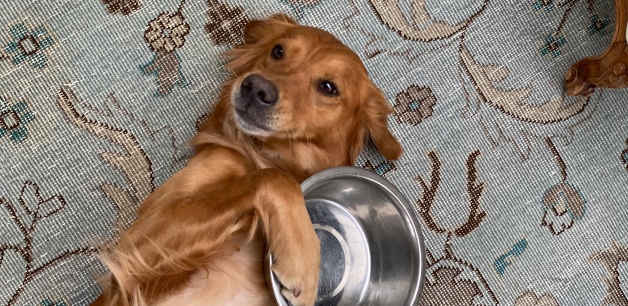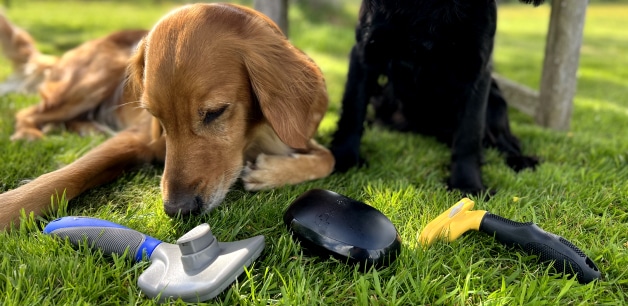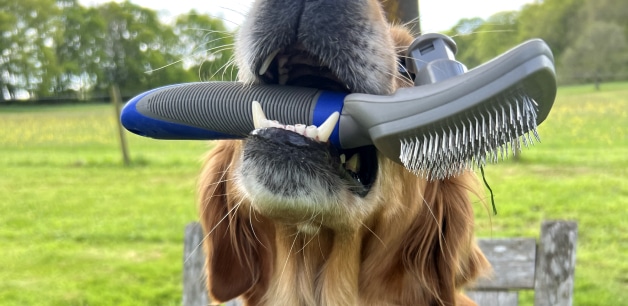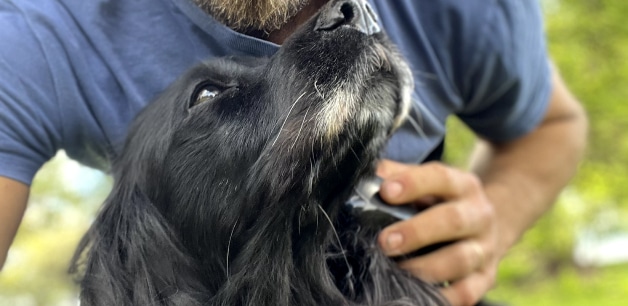Let’s talk grooming
Grooming can be quite an overwhelming subject for some pet parents, but it really doesn’t have to be! Adopting healthy grooming practices can be a great way to keep on top of your dog’s skin and coat maintenance. It also allows the opportunity for you to notice signs of any problems by examining your dog’s coat, skin, eyes, and nails often.
However, it’s also really important to avoid overgrooming, and to only adopt ethical methods that are suitable for your dog’s breed and coat type. That said, grooming your dog should be reserved for maintenance, and not used consistently as a ‘cure’ for ongoing skin and coat issues.
Here’s my guide on how you can help your dog maintain healthy, hydrated skin and a glossy, shiny coat, beginning with the first key step: Feeding them a healthy, nutritious diet.

How does diet affect the health of my dog’s skin and coat?
Navigating the world of pet parenting has been one of the most rewarding experiences of my life. One of the major turning points in my journey was when I discovered raw feeding, and the benefits it had on each of my dogs’ coats.
When I first introduced my dogs to fresh, raw food, the positive changes were astounding, especially of their skin and coat health. Within a few days, I noticed that their fur was shinier, glossier and a lot less matted. Their skin was no longer greasy, dusty or flaky, and instead it appeared consistently healthy and hydrated.
It was clear that my dogs were a lot more comfortable in general, and this was when I realised that feeding a great, healthy diet is the first key step to improving your dog’s skin and coat health.

Ethical coat care: Grooming needs for different breeds
Breed and coat type are both very important factors when it comes to grooming. Below I have listed some common coat types in dogs, including some potential problems you might face.
I have also included tips and tricks for healthy grooming practices which you can adopt, to keep your dog’s skin and coat healthy and hydrated.

Hypoallergenic, non-moulting dogs usually include cross breeds and curly coats such as cockapoos, poodles, malteses and more.
Common coat problems
Breeding of these dogs tends to select for tight, curly coats. These are prone to matting which can pull on the skin, causing discomfort.
Healthy grooming practices
Curly breeds might require brushing more often but not constantly. A pinhead brush is useful to comb through mats gently, and a soft brush for after to help distribute the natural oils throughout the coat.
Some owners of non-shedding breeds might prefer to take their dog to a professional groomer every now and then, to keep on top of coat length. This is a good idea if your dog’s coat grows quickly. Clipping a dog’s coat without any prior experience can be dangerous, so I would always recommend having a professional do this. However, bear in mind that dog groomers aren’t regulated in the UK, so always ensure you do your research beforehand to find a reputable groomer.

Long, silky coat
Long, silky coated breeds can include the cocker spaniel, Yorkshire terrier and Irish setter for example. These breed types generally tend to shed seasonally.
Common coat problems
Long-coated breeds might require brushing when heavily shedding. They’re more prone to matting, especially for active dogs. Matting can be more common around the ears for long eared breeds.
Healthy grooming practices
A Furminator or Tangle Teezer can help to remove shedding fur, especially during spring when shedding is heavy.
For maintenance, gently combing through the fur a few times per week will help to keep any knots at bay.

Short coat
Short-coated breeds such as jack russells and beagles tend to have relatively low maintenance coats, which can be great if you’re a first time dog owner.
Common coat problems
Breeds with a short coat tend to gradually shed all year round.
They can be more prone to seasonal skin rashes and irritation due to having a thin coat.
Healthy grooming practices
A soft, rubber grooming mitt and bristle brush are useful for removing loose, shedding fur from under the coat. You could also use a defurminator for when they’re shedding a lot.
Short-haired dogs tend to have sensitive skin, especially during the spring and summer months. Applying organic, cold-pressed coconut oil to the skin can help to soothe and prevent unwanted seasonal rashes and irritation.
Like with any dog, it’s important not to over-groom or use a harsh, stiff brush. This could irritate or damage the skin under the thin, short coat.

Double coat
Breeds with a double coat, such as huskies and Labrador retrievers, tend to have a high maintenance coat type.
The top coat repels dirt and moisture, whilst the undercoat helps to protect from both hot and cold weather. This is particularly useful for working dogs, such as herding breeds who need insulation when the weather is bad.
Common coat problems
Double coated breeds shed a lot, so they tend to need a lot of grooming to prevent the under coat hairs from getting caught in the top coat hairs, which can cause matting.
If they’re not groomed correctly, they can develop severe matting. This also runs the risk of overheating during the warmer seasons.
Healthy grooming practices
Specialist undercoat rakes and slicker brushes are useful for helping to dislodge a lot of the shedding fur. For maintenance in between, you can use a comb and soft bristle brush to help with oil distribution throughout the coat.
Double coated dogs should never be shaved or clipped – this damages the undercoat and can affect their ability to regulate body temperature.
Some double coated breeds can have feathering and their feet trimmed, but most don’t require trims using scissors.
My number one grooming rule: less is more!
Try not to bathe your dog frequently if you can help it. Bathing too often can strip the natural oils from the coat and cause fur to become dry and brittle, which in turn increases the chances of mats and tangles developing. If you do need to bathe your dog, I would recommend using a natural, unscented canine soap bar or shampoo. Also, I would never recommend using doggy perfume or scented detangling sprays. If your dog’s coat is unusually smelly, dirty or knotty, there will be a reason. A natural diet and potentially vet check would be a good starting point.
It’s important to remember that no two dogs are the same. One long-haired dog for instance might require a different coat care routine to another. This can be due to a number of reasons, including varying coat consistencies and genetics. If you’re unsure of your dog’s requirements, I would recommend to follow the rule of ‘less is more’ to start with. Try some different techniques that are suitable for your dog’s coat type, to see what works and what doesn’t.
The final and most important point is to never over-groom, regardless of breed or coat-type. In general, a dog’s coat can do a very good job of taking care of itself when fed a healthy, nutritious diet. Generally, any manual grooming should be for maintenance reasons, depending on your dog’s skin and coat care requirements.

It’s not dog hair! It’s canine confetti…
I hope this blog has been helpful by sharing my top grooming tips and tricks! Remember, the key first step to a healthy coat is a great diet. If your dog requires it, adopting healthy, ethical grooming practices can help to maintain optimal skin and coat health.
Additionally, I always recommend to take consideration of where your dog likes or doesn’t like to be touched or groomed. Some dogs are more sensitive in certain areas of their body than others. So it’s important to get them used to you regularly checking their paws, eyes, and ears. This will help them to associate grooming with a positive event, and make vet visits a more calming experience too.
If you have any grooming and diet-related questions or queries, please don’t hesitate to reach out to me at james@ella.co, and I’ll be more than happy to help!
James & Ella x
